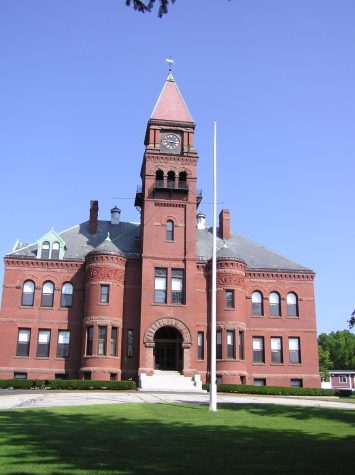Inaccessibility of Pinkerton Building
Students with Physical Disabilities and Injuries Need to Seek other Locations to Learn
June 19, 2023
 When Pinkerton student Lillian Sibona tripped on a puck while playing ice hockey, she hurt her knee and her doctor informed her that she would have to be on crutches and wear a knee brace for the next two weeks. Sibona could not use stairs, but her R1 class is French 2– on the second floor of the chapel. It is impossible to enter the chapel on crutches, so her entire R1 class was moved to a room in the Shepard Building.
When Pinkerton student Lillian Sibona tripped on a puck while playing ice hockey, she hurt her knee and her doctor informed her that she would have to be on crutches and wear a knee brace for the next two weeks. Sibona could not use stairs, but her R1 class is French 2– on the second floor of the chapel. It is impossible to enter the chapel on crutches, so her entire R1 class was moved to a room in the Shepard Building.
This is not the first time this has happened. There are no elevators, no automatic doors, and no ramps anywhere in the chapel. If a student who cannot use stairs has a class in the chapel, their class has to be moved to an empty room in a different building. Pinkerton Academy is the largest high school in New Hampshire, so surely this cannot be an oversight.
The Pinkerton Building (also called Pinkerton Hall, the clock tower, and the chapel) is the second oldest building on campus. When John Morrison Pinkerton died in 1881, he left behind his entire estate to the academy. The Board of Trustees used the money to construct the chapel which was completed in 1887. At the time, there were few (if any) accessibility standards for public buildings.
According to the American with Disabilities Act (ADA), both public and commercial buildings must comply with the Americans with Disabilities Act Accessibility Guidelines (ADAAG). Generally, buildings with three or more stories are required by law to have an elevator, but these laws only apply to buildings occupied after January 26, 1993. Because the chapel was built before accessibility standards became law, it is a difficult building to apply ADA standards. Since it is used for educational purposes, it has to accommodate all students. The school can either renovate it so it complies with the ADAAG or provide suitable alternatives to using the building.
Heather Barrieau, Dean of Support Services, explained how the school had used alternatives over the years
“We try to be preventative in our scheduling of class locations if we are aware that a student or teacher is unable to climb stairs,” said Barrieau. “If something occurs unexpectedly, like an injury, we move classrooms to new locations so that everyone has access. We have a room in the Shepard Building that we can easily move a class into that doesn’t require stairs. We are aware that Pinkerton Hall isn’t able to serve everyone, so we are quick to make accommodations when needed.”
Barrieau noted that this alternative is all the school can offer as of now.
“Making Pinkerton Hall accessible would be the best solution, but at this time, we are only able to make accommodations,” said Barrieau. “This is something on our radar, so we make every effort to meet the needs of all our students and staff by implementing accommodations whenever needed.”
This has been on the Academy’s radar, and for quite some time. Twenty years ago, former architecture teacher Rolfe Voltaire was asked to introduce a project for his class where students would design an elevator shaft and accessible entrance for the chapel while staying true to the original design.
“The preservationist in me would like to save old historic buildings by preserving their architectural integrity but updating and adapting them for accommodation using current building and life safety codes,” said Voltaire. “Take the Pinkerton Building for example… It has been fire alarmed and sprinklered for decades. Why? In big part because life safety codes had changed for public buildings and schools. The law changed.”
Voltaire’s assignment was a challenge for his students who had never worked on a project of this size.
“As smart and talented as many of them were, this would be a steep learning curve. They had never measured a 125ft tall historic building before. They began the project knowing very little if nothing about the ADA, handicapped accessibility, Richardsonian Romanesque architecture, elevators or handicapped accessible restrooms. [It was] a college level project for sure.”
He went on to say that an accessible chapel may come sometime in the future. Voltaire said the construction would not be difficult, however, the process would cost millions of dollars.
“I know from conversations with several Board of Trustee members that it’s something that the school would love to do,” said Voltaire. “I think maybe sometime after the new Social Studies building is up and running, it may be a project that moves to the front burner unless a wealthy donor comes along first.”
Even if the building follows ADA regulations, the impact the chapel’s inaccessibility has on students should not be ignored. Until the chapel’s changes, students with permanent or temporary disabilities will have to continue to avoid it completely, like Sibona and her French class had to.
